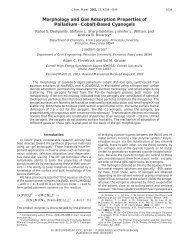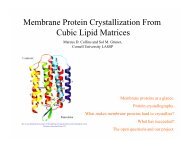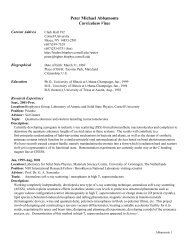Structural and Thermodynamic Characterization of T4 Lysozyme ...
Structural and Thermodynamic Characterization of T4 Lysozyme ...
Structural and Thermodynamic Characterization of T4 Lysozyme ...
You also want an ePaper? Increase the reach of your titles
YUMPU automatically turns print PDFs into web optimized ePapers that Google loves.
Figure 1. <strong>T4</strong> lysozyme structures shown from the same perspective. The external surface <strong>and</strong> buriedcavities (shown in magenta) <strong>of</strong> (a) WT* (1L63), (b) L99A (1L90), (c) L99G/E108V (1QUH), (d) A98L(1QS5), <strong>and</strong> (e) V149G (1G0P) identified with a 1.2 Å probe in MSMS (34) with all internal solventmolecules removed. Cavities are identified by numbers 1 – 10 (refer to Table 2). (f) Cartoonrepresentation <strong>of</strong> WT* <strong>T4</strong> lysozyme. The C-terminal lobe is on the top side.Figure 2. Pressure denaturation <strong>of</strong> <strong>T4</strong> lysozyme mutants in pH 3.0 50 mM glycine 20 mM NaCl(diamond) <strong>and</strong> 100 mM NaCl (circle) buffers monitored at 16 ºC by tryptophan fluorescencespectroscopy. (a) L99G/E108V (open) <strong>and</strong> L99A (closed). (b) V149G (open) <strong>and</strong> A98L (closed).Figure 3. Pressure denaturation <strong>of</strong> L99G/E108V (diamond), L99A (circle), <strong>and</strong> WT* (plus) <strong>T4</strong>lysozyme in pH 7.0 50 mM Tris HCl 20 mM NaCl buffer monitored at 24 ºC by tryptophanfluorescence spectroscopy.Figure 4. (a) Radius <strong>of</strong> gyration, R g , as a function <strong>of</strong> pressure for 10 g/l L99A in 50 mM glycine100 mM NaCl pH 3.0 buffer at room temperature. R g was determined by a Guinier fit to the qR g < 1.3region <strong>of</strong> scattering pr<strong>of</strong>iles taken at each pressure. The error bars are larger at high pressure becauseonly one exposure was taken at each pressure. At lower pressure, the sample was less susceptible toradiation damage-induced aggregation <strong>and</strong> multiple exposures were taken at each pressure, whichenabled averaging <strong>of</strong> images. A two-state thermodynamic fit is shown (solid line) to guide the eye. (b)The zero-angle scattering intensity <strong>of</strong> L99A (circle) <strong>and</strong> the WT* (diamond) at pH 3.0. WT* does notdenature below 300 MPa.Figure 5. (a) Pair distance distribution functions <strong>of</strong> native (28 MPa, solid line) <strong>and</strong> denatured (300 MPa,dotted line) L99A <strong>T4</strong> lysozyme at pH 3.0 obtained with GNOM (28). Inset: Kratky representation <strong>of</strong> the28 MPa (1) <strong>and</strong> 300 MPa data (2). (b) The scattering pr<strong>of</strong>ile <strong>of</strong> L99A at 300 MPa (black) was examinedwith the Ensemble Optimization Method (30). An ensemble <strong>of</strong> unfolded conformers with residualstructure (red scattering pr<strong>of</strong>ile) better described the experimental data compared to an ensemble <strong>of</strong>38









